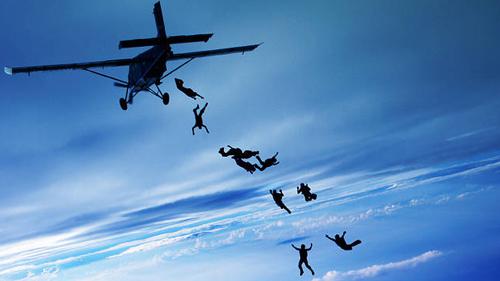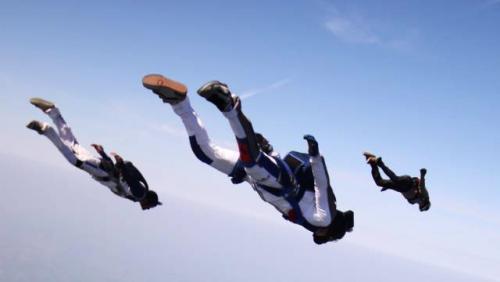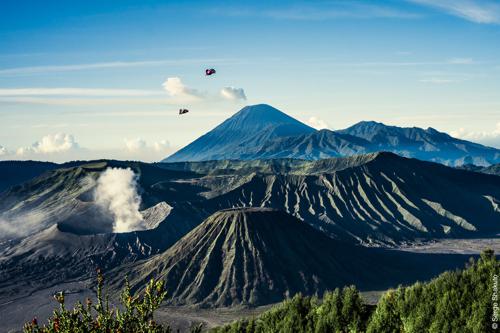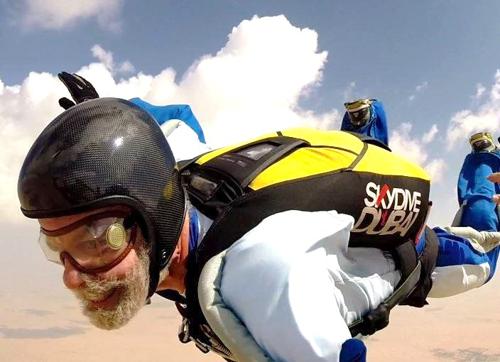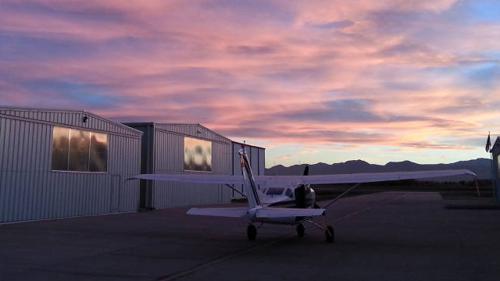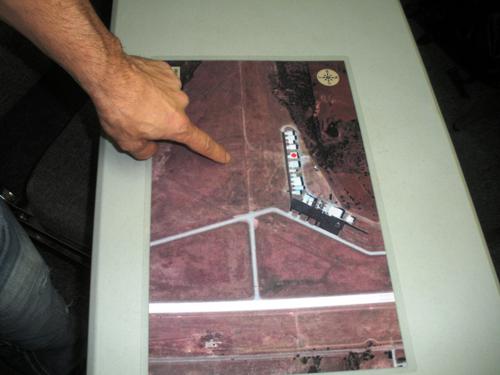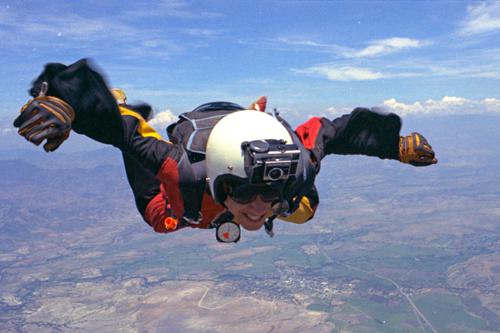The Horizontal Flight Problem
By Bryan Burke, S&TA; at Skydive Arizona
Identifying the Problem
All of the following events took place during our spring 2013 season here at Skydive Arizona. Some have been repeated several times. Since I started to look into this subject and inquire as to what other drop zones are seeing, several similar incidents have been brought to my attention. In addition, there are several reports of serious freefall collisions that have resulted from tracking, angle, and wingsuit dives around the world.
Example One
Angle flying dives, also known as atmonauti or tracing dives, are recording fall rates comparable to freeflyers. They not only fall faster than true trackers, they do not cover nearly the horizontal distance that true tracking dives do. (Inexperienced trackers, especially on their backs, often have essentially the same flight characteristics, much faster down than experienced trackers and not much horizontal travel.) In one case, a group of very experienced angle fliers insisted on exiting first, saying they were trackers. They fell at freefly speeds, about 170 miles per hour. The dive was planned to go roughly 90 degrees to the line of flight, but they didn’t go very far, covering less than half the distance a real tracking dive would. This type of dive tends to include a lot of highly experienced freeflyers experimenting with new stuff, so they were jumping very fast canopies and opening between 3,000 and 3,500.
A conventional belly flying group followed them out. They had a long climb-out, about 15 seconds, broke off at 4,500 feet, tracked, and deployed between 3,000 and 2,500. All of them were experienced and competent trackers in the conventional sense of the word.
There was nothing unusual about the conditions. Up on the jump run, the airplane was covering ground at 150 feet per second (about 90 knots) and the horizontal distance between Group 1 and Group 2 at exit would be about 2,250 feet. Because of the longer freefall time for the second group, about 500 feet of that was lost to freefall drift in the winds aloft. This leaves their hypothetical center points at opening about 1,750 horizontal feet apart, still adequate separation for two conventional belly flying groups opening within a few seconds of each other.
However, because of their fast freefall speed, followed by the climb-out time for the second group, the angle fliers deployed their parachutes nearly thirty seconds before the second group, but also 500 to 1,000 feet higher. They immediately turned towards the landing area under canopy; otherwise they would not get back, at least not with enough altitude for a big swoop. During that thirty seconds, they only dropped about 700 - 1,000 feet or so vertically, but they covered between 1,500 and 1,800 horizontal feet in that time. This does not even take into account the ground covered by tracking at break-off from either group.
Canopy winds were light. In thirty seconds, a modern fast canopy in normal straight flight will do 60 feet per second horizontally. That puts them 1,800 feet back towards the DZ and line of flight. Mentally, skydivers tend to think freefall separation is an exit problem, not a canopy problem. Once they have a good canopy, they are conditioned to think about canopy traffic and their landing – not about what might be in freefall overhead, because in the past this has not been a problem since we figured out that fast fallers should follow slow fallers out in the exit sequence.
So, at about 2,500 feet the two groups effectively merged into a single large mix of deploying freefallers and people already under very fast parachutes. The only reason there were no collisions was blind luck. Mind you, every one of these jumpers was experienced, current, and well trained within the existing paradigm.
Example Two
A very experienced jumper with a cutting edge wingsuit was logging freefalls of over three minutes and opening at about 3,500. We had three aircraft flying. Our procedure is to leave a minimum of two minutes between drops for conventional freefall loads, three with wing suits or students, and four after a load with tandems. The wingsuit jumper exited. The plane behind started a three minute clock. Although the wingsuiter opened about half a mile away from the jump run, he then made a riser turn towards the landing area and left the brakes stowed as he fiddled with his suit. A minute later, he was just under 2,500 when canopies were opening around him.
Example Three
Taxiing out from the loading area, the pilot called me to ask which way trackers should go. This piqued my curiosity, trackers are supposed to know this when they manifest. I told him “east” and asked if he could tell where they were in the exit order. Meanwhile I checked with the manifest to see if anyone on that load had reported they were planning to track or asked for information about which way to go. None had. A bit later the pilot replied that they would be exiting first. I got out my binoculars to watch.
The three-way tracking group exited and flew straight up the line of flight, opening between the next two groups in the exit order. Naturally I noted their canopies and rounded the three up in the landing area for a discussion. Initially they were confused about what the problem was, although they did acknowledge that there were other canopies in the sky closer than they had expected.
The leader of the dive had seventy jumps. It was his first tracking dive, and he was leading it on his back. He had planned to turn off jump run and fly east and was completely unaware of his failure to do so. The other two had about 150 and 200 jumps, not enough to be aware that he had failed to turn. Even if they had been, there was no plan on how to signal course corrections to the leader, and they were not close enough to do so in any case, due to the lack of experience. Two of the three, including the one with 70 jumps, had GoPros on, which no doubt distracted them from the navigation problem as they tried to video each other. It was a de-briefing nightmare as I learned more and more about how much they did not know. It was their first time at a large, busy drop zone. They had never received any coaching or advice on tracking. They had no idea about USPA’s recommendations for jumping with a camera.
This episode made me realized that the manifest in-briefing that had served us well for years, with minor modifications now and then, was no longer adequate. In the past we never felt the need to screen for camera use or horizontal flying, merely informing them that if they were planning to track or wingsuit they would need to get a daily update from the safety officer.
Example Four
A total of twelve wingsuit jumpers landed out, the nearest almost half a mile from our normal landing area, the farthest over a mile out. After I rounded up the entire group (not one of them local jumpers) I made it plain that this was unacceptable, not just from a safety point of view, but also because many of them landed on private property or public roads, not a good thing in terms of our relations with the community. Questioning them about their flight planning, I learned some very interesting things. First, it was two groups, not one. The less experienced group was planning to take an “inside track” while the second, more experienced group was planning to fly a wider course, both of the tracks parallel to the original jump run. (This is a fairly common practice at DZs with a lot of wingsuit activity.)
To make this easier, the individual who had taken charge of planning asked the pilot to turn 90 left at the end of the regular skydiver jump run. In theory the two wing suit groups would then simply exit and turn 90 left, paralleling the normal jump run back to the DZ and gaining horizontal separation from the climb-out time on jump run.
Unfortunately this plan did not take into account that the winds aloft were about 30 knots out of the west, and the standard jump run was south. Thus, a left turn gave the plane a ground speed of about 130 knots, and each group took quite a while to climb out. Once in flight, they were already well down wind of the planned flight area and would have more cross-wind push the entire flight.
Clearly this plan was doomed from the start, and anyone who had the slightest idea what the winds aloft were doing would know this. Winds aloft are very easy to find on line these days, or someone could have simply asked the Safety Officer what his observations were. Not one of those twelve wingsuiters questioned the incredibly bad plan the group leader had come up with, which was based on completely wrong assumptions. Even if anyone had looked down, they were already committed and had no Plan B.
Example Five
I picked up a wingsuit jumper who landed over a mile off the dz. (Nearly 1.5 statute miles, in fact.) The only reason I even knew about him was a bystander saw his canopy in the distance and pointed him out. I never would have seen him, his opening point was well beyond our first exit group on the normal jump run! His story? With very little experience on his new high performance suit, he was jumping a new helmet and camera set-up for the first time. He reported that he had problems with the helmet throughout the flight (shifting and vibrating) and forgot to pay attention to where he was going, flying downwind and away from the DZ the entire time.
Example Six
Trackers landed out, on the approach to the runway. When I inquired about the flight plan they said that when they got to the airplane, there was another tracking dive. The two groups decided to exit first and second, each going 90 degrees to the jump run in opposite directions. This put the out-landing group exiting at the extreme early end of the jump run, tracking downwind, then faced with penetrating back into the canopy winds. They had no chance to make it to the normal landing area and their opening position put them in a canopy descent to a clear area directly on the extended centerline of the runway.
These are real world examples at one drop zone over the course of a mere couple of months. Along with similar problems reported from other drop zones and the incidents of actual and near-miss collisions associated with horizontal dives, it seems clear that training in these fields is completely inadequate.
Before Freeflying came along in the early 90s, the skydiving environment was very simple. Everyone fell almost straight down and parachutes flew about 25 miles per hour. In the 90s, we had to figure out how to deal with a new, much faster fall rate in some groups, and canopies almost doubled in horizontal speed. In the last decade, even more variations in skydiving have popped up. These didn’t really show up much on DZO’s radar because so few people were doing them, but now they are increasingly common.
Approximate Speeds of Various Forms of Skydiving Activity*
Activity Vertical Speed Range Horizontal Speed Range Freefall time (13,000)
FS 120 – 130 mph 0 – 20 mph** 00:60 - 65
Freefly 150 – 180 0 – 20** 00:40 – 50
Tracking 120 – 140 30 – 60*** 00:55 – 65
Angle 140 – 160 20 – 40*** 00:45 – 50
Wingsuit 40 – 70 50 – 80*** 01:30 – 3:00
*Approximations derived from videos and recording altimeters.
**Random drift due to things like backsliding, one side of the formation low, etc.
***Best guess, based on distance covered in freefall time.
Thus, on a single load there might be freefall times from exit at 13,000’ to opening at 3,000’ as little as :40 seconds and as much as three minutes. Horizontal speeds will range from zero to 80, with distances of up to a mile on tracking dives and flights of several miles possible for expert wingsuit jumpers. Note that these speeds will vary considerably. For example, experimenting with tracking myself and observing tracking contests, I could get well over a mile in 60 seconds and many people can out-track me by a significant margin. However, actual tracking dives are usually not done in a max track position because it doesn’t lend itself to maneuvering with others. On a calm day, a tracking dive going 90 off the line of flight usually only covers about half a mile.
Identifying the Risks
Collisions within Groups
Within groups, tracking, wingsuit, and angle dives are showing a disproportionately high rate of collision injuries. Even the best planned dives can still involve high closing speeds as the group forms and breaks up. And, as Bill von Novak has pointed out:
On a tracking dive there is no focal point; no base you can dock on or, failing that, at least keep in sight for break-off. Everyone tracks in effectively a random direction at the end of the dive and hopes for clear air. In some cases they even barrel roll just to add some more randomness to their directions. To a newbie a tracking dive sounds lower pressure than a big-way; you don't have to dock, you just have to go in a similar direction as the leader. This tends to attract lower experienced jumpers, and those jumpers often shed the jumpsuit they are used to for a freefly suit or no suit at all - resulting in new and hard to predict fall rates/forward speeds.
To that I have to add the potential for huge closing speeds, sometimes due to lack of skill but often due to poor organizing. Tracking dives in particular have a history of being “loose” or “pick-up” loads. Many times I have seen people “organizing” a tracking dive by making a general announcement to give a ticket to manifest if you want to come along. There is often very little screening for experience and ability.
Then, it is common to group the more experienced people close to the leader, and that person is often in a floater position on exit. Anyone who can remember learning to do larger formations knows that novice divers tend to dive too long, even if they have been forewarned about the problem. (If you dive out two or three seconds after the base, that base is way ahead of you on the acceleration curve, so they appear to be getting further away – which they are. You dive more aggressively, something you don’t have much practice at. Then, when the base hits terminal velocity, they suddenly rush up at you because you are now going much, much faster than the base. You then go low, or collide.)
Now add to that the significant horizontal movement, burbles that aren’t directly above the lower jumper, multiple vertical levels, and huge blind spots since you are looking ahead, not around. The potential for collisions is incredibly obvious once you think about it, but apparently few people doing tracking dives are thinking about it.
Collisions Between Groups
Although these are still rarely found in the accident record, I have seen many near misses, which suggests that it is only a matter of time. This is particularly disturbing to me because in a group-to-group collision, it means someone was exposed to an extreme hazard that they had no knowledge of, expectation of, or control over. Skydiving is risky enough with the known hazards. As drop zone operators and safety professionals it is morally wrong to expose our customers to a risk where their only real control would be to look at who else is on the load, and pull off it.
Landing Out
Out landings have two problems, one a risk to the jumper and the other, to the drop zone itself. The record shows that out landings have a high risk of landing injuries, especially from low turns to avoid obstacles or turn into the wind. This risk is exacerbated by the fact that the drop zone staff might not even know of an injury, and if they do, the response can be complicated.
The second risk is aggravating the neighbors or airport authorities. Every drop zone has at least some neighbors or authorities who are opposed to skydiving. As long as these are a small minority a DZ can usually get by. Once skydivers start dropping into neighborhoods, landing on runways, and otherwise drawing unwelcome attention, the political balance can change. A classic example of this is the tracker landing on the roof of a two-story house 1.3 miles south of the DZ at Longmont, Colorado early in July of 2013. He not only broke his leg, he damaged the roof and required a complex rescue. At the time of the incident, he had 64 jumps in over a year in the sport. The wind was blowing from the north, but he tracked south, towards a heavily developed suburban area. In his own remarks, he accepts no responsibility for the incident, blaming it entirely on the winds rather than his extremely poor planning.
Changing the Paradigm
What do these activities all have in common, from the standpoint of skydiving culture? There is very little expectation, or even definition, of quality. Success is defined as mere participation and survival. Near collisions, actual collisions, landing out, and other problems do not seem to be perceived as failure. The video evidence alone is proof of this attitude. Just randomly browse YouTube for tracking, wingsuit, and angle dives and you’ll see some really bad, sometimes frightening, flying. Yet the comments are almost never critical. In order to turn this around, drop zones will have to set higher standards and change the definition of acceptable.
This is not the first time we’ve been down this road. I started skydiving in 1978. Sequential FS was really starting to take off, but for the typical jump group there was no reason to plan a second point. As an old friend of mine said of those days, “I remember when a good 8-way was a 4-way!” It was learn by doing, and we had a lot of accidents from the hard docks, funnels, and collisions on the way to and from the funnels. But we learned a lot, and fifteen years later, when freefly came along, RW was at a pretty advanced, safe stage of technique.
Those who were around in the early days of freeflying saw history repeat itself. Freeflyers didn’t want to dirt dive, debrief, or set goals. That was for RW jumpers, and anything to do with RW wasn’t cool. It was simply “Let’s jump together and do some tricks.” Eventually, they came to realize that just led to a lot of wasted jump tickets, AAD fires, and hard knocks in freefall. Now freeflying uses exactly the same philosophy as FS: train, set goals, set standards, and most of all, plan dives appropriate to the experience and ability of the participants.
Now we see a new discipline emerging. On the one hand, angle flying is somewhat like freefly, where the recruits are already fairly experienced skydivers. Tracking is often more like early RW, where there was not a lot of skill among many of the participants, and not much meaningful leadership from the ones who had managed to survive.
Wingsuiting seems to be in a class by itself, a population split between regular skydivers wanting to try something new, and BASE jumpers who feel that rules are a curse. One thing most of them seem to lack is good training about the surrounding environment.
Training
The general lack of training, supervision, and experience in this field is part of the problem. For example, although most wingsuiters take a first flight course of some type, I have visited web sites naming instructors with as few as 300 total jumps and only 100 wingsuit jumps! Based on the quality of some wingsuit jumpers, clearly some instructors have pretty low standards as well as low skills. All of the training materials I have seen make some mention of navigating and awareness of wind conditions, yet not one of the wingsuit jumpers I have spoken to after they land out has reported that their instruction included specific details on how to plan an effective flight path. After debriefing countless wingsuit incidents including malfunctions, traffic problems with other jumpers, out landings, and so on, I have come to conclude that a USPA Wingsuit Instructor Rating is a good idea. Training should included a detailed syllabus and written and practical tests, including flight planning, before they receive a wingsuit endorsement. At present it cannot be assumed that any wingsuit jumper has adequate training.
Tracking attracts people with very little experience and has even less formal training than wingsuiting. It is perceived as something anyone off student status can do, since there is no need for enough skill to dock on a formation or turn points. In fact, some tracking dives are put together with the clear expectation that some participants won’t even be able to keep up. Since tracking itself is perceived as easy, I believe this translates into a mind-set that there is nothing to worry about. Hence we see very poorly organized dives with little or no screening for ability or experience, and often no meaningful flight planning.
Angle flying also requires better screening for skill. Initially this activity was mainly undertaken by highly skilled freeflyers, but now that it has been popularized on media sites a lot of less experienced jumpers want to get involved. Like tracking, these dives require a flight plan that takes into account the rest of the load, and the high descent rate. In my opinion angle flying is more akin to freeflying than to tracking, and should exit in conventional freefly order with great attention to flying 90 degrees off the line of flight but not into the same airspace that slower falling trackers may also be heading for.
Standards for Experience and Participation
Unlike Freeflying and Formation Skydiving, horizontal flying cannot be learned in a wind tunnel. The only way to acquire skill is to actually do it. As everyone knows from learning Formation Skydiving or Freeflying, you don’t take people with 70 jumps up on large formations with mixed experience levels and minimal planning – at least not with a reasonable expectation of safety and success. We also know that you don’t develop skills very effectively if you have no expert coaching - or at least competent leadership. This should include goals set for the skydive before you are on the way to altitude, a useful dirt dive, and then a good post-dive debriefing, ideally with a video that is useful, not a sloppy, shaky GoPro video with constantly changing reference points.
After giving it extensive consideration, I’m planning to screen new arrivals much more aggressively and have minimum standards they will have to adhere to.
Just as most skydiving associations feel 200 jumps is a good minimum for wingsuits and cameras, fifty is a good number for a night jump, and so on, I feel that tracking dives should not be undertaken, except as one-on-ones with an experienced coach or instructor (or approved solos after consulting with an I or STA) until 100 jumps. At that point, the jumper can go on slightly larger tracking dives led by a coach, instructor, or approved organizer.
For those with more jumps just taking up tracking, I feel that regardless of experience your first ten tracking dives should be with an approved Coach, Instructor, or organizer and these individuals should have an understanding with the dz about keeping the dives small and simple, just as we would with an expert FS jumper exploring freeflying.
To lead a tracking or angle flying jump, I am thinking about a minimum of five hundred jumps, including at least 25 tracking jumps (and 25 angle flying jumps for that activity, not a total of 25 combined). The minimum skill set to lead will include awareness of collision risks and how to mitigate them, the importance of staying away from the jump run, how to make a flight plan that guarantees everyone will get back, how to plan with other groups on the load to ensure adequate separation, etc. Leaders must screen all participants for skill and have a well planned dive from exit to opening. Dives for which anyone can sign up by bringing a ticket to manifest are not allowed. Leading on the back is not allowed unless paired with another skilled tracking leader as a co-pilot flying face down.
Information, Screening, and Guidelines
Skydive Arizona’s plan to get better information out and establish our intentions and expectations with the horizontal community is simple. Once our procedures are established, or whenever we change them, the procedures will be posted on our web site, displayed near the loading area on a multi-sided “Safety Kiosk,” and available as flyers or hand-outs at manifest. As jumpers arrive they will be asked if they have any intention of participating in horizontal jumps. If so, they will receive the hand-out and a special briefing, in addition to the usual DZ briefing. Depending on their experience level they may be limited in what they can do, or directed to our coaching department. (Although the GoPro problem is only peripheral, we’ll be adopting a similar strategy there.)
Drop Zone SOPs
Besides improved training, screening for skill and experience, and better coaching and organizing, drop zones can also implement standard operating procedures to mitigate some risks.
Exit Order
The phenomenon discussed in Example 1, above, indicates that angle flyers should never go before belly flyers. If they do, we not only have the well known problem of differential freefall drift in winds (the faster fallers drift less, the slower ones, more) but we then combine that with fast canopies having 20 or 30 seconds of flight to eliminate any remaining horizontal separation. This has already happened here, at Elsinore, and on the east coast that I know of; doubtless it has happened elsewhere.
Trackers can leave just about anywhere in the order, provided the flight plan works with the overall scheme of things. If they have a slow fall rate and a fast horizontal rate, leaving first works fine, providing the leader takes a course that does not put them too far away. In practice, the pilot is always trying to get the first group off the plane at the earliest possible point from which they have a reasonable chance of getting back. This creates the best opportunity to get the entire load out on one pass. If the trackers leave first and fly 90 off the jump run, they are now further out than that “earliest possible” point. Leaving first, they must do a minimum of 45 off the line of flight, or 90 for half the jump followed by 45 for the rest, or 60 the entire time - something that gains a little ground back towards the dz while at the same time getting well clear of the jump run.
Clearly, any exit position still presents the possibility of a tracking group flying up or down the jump run. The only way to mitigate this risk is to limit tracking leadership to experienced, well trained skydivers.
Flight Planning
I will be asking everyone in the horizontal community to take much more responsibility in flight planning. As I see it, the proper planning procedure has several steps.
Get a clear understanding of the overall DZ geography. If, for example, going to the right of the line of flight will put you over the ocean while going left will put you over a safe, open field, left might be the best choice if winds allow.
Get current wind conditions, exit to surface.
Find out if there are any other special concerns, such as a second plane dropping military or CF jumpers in an airspace box adjacent to the normal jump run.
Plan an opening point from which everyone can safely get back to the DZ.
From that point, reverse engineer the freefall portion taking into account never flying under or over the jump run and avoiding other horizontal groups on the plane.
In the event that winds, geography, other DZ activity, or some other issue makes it unlikely that all points of the flight plan will be successful, cancel the dive until conditions are more favorable. On every dive we will hold the flight leader responsible for devising such a plan and executing it properly. Any safety infractions or out landings will result in grounding until they can prove they understand the situation better and have devised a strategy to prevent a repeat.
Per Load Limits
Depending on whether or not the DZ and jump run offer the option of flying to both sides of the line of flight, it is possible to get up to four horizontal groups out of a plane safely. If the airspace is limited to just one side of the jump run, three seems to be about the limit. I’m more concerned with keeping everyone safe than with pleasing everyone if significant risks are involved, so we will start limiting the number of horizontal jumps on any given load. On this subject of pleasing customers, the situation is analogous to the HP landing problem. If the risk is to the participant only, then a little extra risk might be considered acceptable. However, when other skydivers have no control over the risk, it is completely unfair to expose them to it. Just as HP landings don’t belong in the normal traffic pattern, horizontal flight that might endanger other groups on the load is not acceptable.
Minimum and Maximum Opening Altitudes
I am not a great believer in relying on vertical separation, since a stuck pilot chute, premature deployment, or spinning malfunction can erase it in seconds. However, there is no reason not to add it to the arsenal. Some drop zones are mandating a minimum 4,000 foot deployment altitude for wingsuits and a maximum 3,000 for trackers and angle flyers. I haven’t made a decision on this yet, but it makes sense in some situations.
Enforcement
After the alarming close calls in our last season, and looking back on the canopy discipline problem that plagued the sport for years (and still does, in places) Skydive AZ recognizes that modifying behavior requires both positive guidance and, when necessary, some penalties. We’ll be asking horizontal flyers who create safety problems to stand down from their activity until they can demonstrate a better understanding of our concerns.

